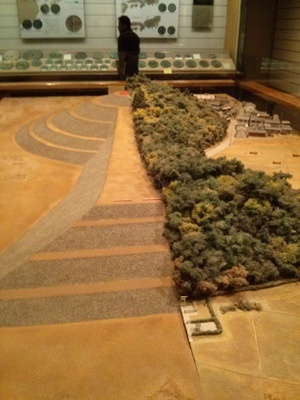Difference between revisions of "Kofun Period"
(Created page with "right|thumb|400px|A model of [[Hashihaka kofun, one of the earliest examples of the keyhole-shaped tomb mound, showing both the tree-covered appea...") |
|||
| Line 5: | Line 5: | ||
The largest ''kofun'' are found in the [[Kinai]] region (in and around [[Nara]], [[Kyoto]], and [[Osaka]]), but roughly 150,000 tomb-mounds of various sizes are strewn throughout most of the main three islands of the archipelago (excluding [[Hokkaido|Hokkaidô]] and the [[Ryukyu Islands|Ryûkyû Islands]]) | The largest ''kofun'' are found in the [[Kinai]] region (in and around [[Nara]], [[Kyoto]], and [[Osaka]]), but roughly 150,000 tomb-mounds of various sizes are strewn throughout most of the main three islands of the archipelago (excluding [[Hokkaido|Hokkaidô]] and the [[Ryukyu Islands|Ryûkyû Islands]]) | ||
| + | |||
| + | Though the end of the political and cultural circumstances of the Kofun Period, and the termination of the construction of ''kofun'', cannot be pegged to a specific date or event, historians often cite the introduction of [[Buddhism]] in or around [[538]] as marking the end of the Kofun Period and the beginning of the Asuka Period, a period when the adoption of numerous [[Tang Dynasty]] political, legal, and cultural elements set the foundation for the heavily Chinese-influenced classical/traditional "Japanese" culture and state that would continue to develop over many centuries, down to today. | ||
{{stub}} | {{stub}} | ||
Revision as of 15:30, 25 September 2013

- Japanese: 古墳時代 (kofun jidai)
The Kofun period extends from roughly 250 CE to roughly 550 CE, and is marked by the prevalence of large tomb-mounds or tumuli, called kofun in Japanese, in which royalty and other elites were buried. The Kofun period and the Asuka period (538-710) which follow it together comprise the Yamato period, the period of time in which a centralized polity, the Yamato state, first formed, developed, strengthened, and grew into the proto-Japanese state.
The largest kofun are found in the Kinai region (in and around Nara, Kyoto, and Osaka), but roughly 150,000 tomb-mounds of various sizes are strewn throughout most of the main three islands of the archipelago (excluding Hokkaidô and the Ryûkyû Islands)
Though the end of the political and cultural circumstances of the Kofun Period, and the termination of the construction of kofun, cannot be pegged to a specific date or event, historians often cite the introduction of Buddhism in or around 538 as marking the end of the Kofun Period and the beginning of the Asuka Period, a period when the adoption of numerous Tang Dynasty political, legal, and cultural elements set the foundation for the heavily Chinese-influenced classical/traditional "Japanese" culture and state that would continue to develop over many centuries, down to today.
| Previous Period Yayoi Period |
Kofun Period | Following Period Asuka Period |
References
- Conrad Schirokauer, David Lurie, and Suzanne Gay, A Brief History of Japanese Civilization, Wadsworth Cengage (2013), 11-15.